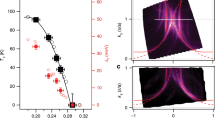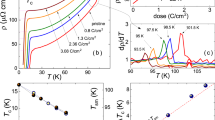Abstract
In conventional superconductors, the electron pairing that allows superconductivity is caused by exchange of virtual phonons, which are quanta of lattice vibration. For high-transition-temperature (high-Tc) superconductors, it is far from clear that phonons are involved in the pairing at all. For example, the negligible change in Tc of optimally doped Bi2Sr2CaCu2O8+δ (Bi2212; ref. 1) upon oxygen isotope substitution (16O → 18O leads to Tc decreasing from 92 to 91 K) has often been taken to mean that phonons play an insignificant role in this material. Here we provide a detailed comparison of the electron dynamics of Bi2212 samples containing different oxygen isotopes, using angle-resolved photoemission spectroscopy. Our data show definite and strong isotope effects. Surprisingly, the effects mainly appear in broad high-energy humps, commonly referred to as ‘incoherent peaks’. As a function of temperature and electron momentum, the magnitude of the isotope effect closely correlates with the superconducting gap—that is, the pair binding energy. We suggest that these results can be explained in a dynamic spin-Peierls picture2, where the singlet pairing of electrons and the electron–lattice coupling mutually enhance each other.
This is a preview of subscription content, access via your institution
Access options
Subscribe to this journal
Receive 51 print issues and online access
$199.00 per year
only $3.90 per issue
Buy this article
- Purchase on Springer Link
- Instant access to full article PDF
Prices may be subject to local taxes which are calculated during checkout



Similar content being viewed by others

References
Franck, J. P. in Physical Properties of High Temperature Superconductors IV (ed. Ginsberg, D. M.) 189–293 (World Scientific, Singapore, 1994)
Pytte, E. Peierls instability in Heisenberg chains. Phys. Rev. B 10, 4637–4642 (1974)
Müller, K. A. On the oxygen isotope effect and apex anharmonicity in high-Tc cuprates. Z. Phys. B 80, 193–201 (1990)
Bianconi, A. et al. Determination of the local lattice distortions in the CuO2 plane of La1.85Sr0.15CuO4 . Phys. Rev. Lett. 76, 3412–3415 (1996)
Gweon, G.-H., Zhou, S. Y. & Lanzara, A. Strong influence of phonons on the electron dynamics of Bi2Sr2CaCu2O8+δ . J. Phys. Chem. Solids (in the press)
Lanzara, A. et al. Evidence for ubiquitous strong electron-phonon coupling in high-temperature superconductors. Nature 412, 510–514 (2001)
Allen, J. W., Gweon, G.-H., Claessen, R. & Matho, K. Fermi liquids and non-Fermi liquids—The view from photoemission. J. Phys. Chem. Solids 56, 1849–1853 (1995)
Bogdanov, P. V. et al. Evidence for an energy scale for quasiparticle dispersion in Bi2Sr2CaCu2O8 . Phys. Rev. Lett. 85, 2581–2584 (2000)
Kaminski, A. et al. Renormalization of spectral lineshape and dispersion below Tc in Bi2Sr2CaCu2O8+δ . Phys. Rev. Lett. 86, 1070–1073 (2001)
Johnson, P. D. et al. Doping and temperature dependence of the mass enhancement observed in the cuprate Bi2Sr2CaCu2O8+δ . Phys. Rev. Lett. 87, 177007–177010 (2001)
Zhou, X. J. et al. Universal nodal Fermi velocity. Nature 423, 398 (2003)
Sato, T. et al. Observation of band renormalization effects in hole-doped high-Tc superconductors. Phys. Rev. Lett. 91, 157003 (2003)
Eliashberg, G. M. Interactions between electrons and lattice vibrations in a superconductor. Zh. Eksp. Teor. Fiz. 38, 966–976 (1960); Sov. Phys. JETP 11, 696–702 (1960)
Verga, S., Knigavko, A. & Marsiglio, F. Inversion of angle-resolved photoemission measurements in high-Tc cuprates. Phys. Rev. B 67, 054503 (2003)
Hwang, J., Timusk, T. & Gu, G. D. High-transition-temperature superconductivity in the absence of the magnetic-resonance mode. Nature 427, 714–717 (2004)
Rotenberg, E., Schaefer, J. & Kevan, S. D. Coupling between adsorbate vibrations and an electronic surface state. Phys. Rev. Lett. 84, 2925–2928 (2000)
Cuk, T. et al. Coupling of the B1g phonon to the anti-nodal electronic states of Bi2Sr2Ca0.92Y0.08Cu2O8+δ . Preprint condmat/0403521 at 〈http://www.lanl.gov〉 (2004); Phys. Rev. Lett. (submitted)
Zhao, G. M., Hunt, M. B., Keller, H. & Müller, K. A. Evidence for polaronic supercarriers in the copper oxide superconductors La2-xSrxCuO4 . Nature 385, 236–240 (1997)
Crespi, V. H. & Cohen, M. L. Anharmonic phonons and the anomalous isotope effect in La2-xSrxCuO4 . Phys. Rev. B 44, 4712–4715 (1991)
Sawatzky, G. A. Testing Fermi liquid models. Nature 342, 480–481 (1989)
Shen, Z.-X. & Schrieffer, J. R. Momentum, temperature, and doping dependence of photoemission lineshape and implications for the nature of the pairing potential in high-Tc superconducting materials. Phys. Rev. Lett. 78, 1771–1774 (1997)
Norman, M. R. et al. Unusual dispersion and line shape of the superconducting state spectra of Bi2Sr2CaCu2O8+δ . Phys. Rev. Lett. 79, 3506–3509 (1997)
Paci P. et al. Polaronic and nonadiabatic phase diagram from anomalous isotope effects. Preprint condmat/0405053 at 〈http://www.lanl.gov〉 (2004).
Pan, S. H. et al. Microscopic electronic inhomogeneity in the high-Tc superconductor Bi2Sr2CaCu2O8+δ . Nature 413, 282–285 (2001)
Anderson, P. W. Theory of dirty superconductors. J. Phys. Chem. Solids 11, 26–30 (1959)
Crawford, M. K. et al. Oxygen isotope effect and structural phase transitions in La2CuO4-based superconductors. Science 250, 1390–1394 (1990)
Lanzara, A. et al. Oxygen-isotope shift of the charge-stripe ordering temperature in La2-xSrxCuO4 from X-ray absorption spectroscopy. J. Phys. Condens. Matter 11, L541–L546 (1999)
Shengelaya, A., Brunn, M., Kochelaev, B. I., Safina, A., Conder, K. M. & Müller, K. A. A metallic phase in lightly doped La2-xSrxCuO4 observed by electron paramagnetic resonance. Preprint cond-mat/0310152 at 〈http://www.lanl.gov〉 (2003); Phys. Rev. Lett. (in the press)
Zech, D., Keller, H., Conder, K., Kaldis, E., Liarokapis, E., Poulakis, N. & Müller, K. A. Site-selective oxygen isotope effect in optimally doped YBa2Cu3O6+x . Nature 371, 681–683 (1994)
Zimanyi, G. T., Kivelson, S. A. & Luther, A. Superconductivity from predominantly repulsive interactions in quasi one-dimensional systems. Phys. Rev. Lett. 60, 2089–2092 (1988)
Acknowledgements
We are grateful to K. A. Müller, A. Bianconi, N. L. Saini, D. Pines, A. Bill, V. Z. Kresin, S. A. Kivelson, A. J. Leggett, J. Clarke, J. Orenstein, M. L. Cohen, L. Pietronero, E. Cappelluti, J. C. Davis, J. W. Allen, A. S. Alexandrov, J. C. Phillips, A. H. Castro Neto, C. Castellani, A. Bussman Holder, D. Mihailovic, G. Deutscher, C. Bernhard, S. Uchida and T. Schneider for discussions. We thank Z. X. Shen, Z. Hussain, D. S. Chemla and N. V. Smith for support in the initial stage of the project. The work at UC Berkeley and LBNL was supported by the Department of Energy's Office of Basic Energy Science, Division of Materials Science.
Author information
Authors and Affiliations
Corresponding author
Ethics declarations
Competing interests
The authors declare that they have no competing financial interests.
Supplementary information
Supplementary Methods
Description of isotope substitution process used. (DOC 22 kb)
Supplementary Figure
Fermi surface maps for the two isotope samples compared. (DOC 79 kb)
Rights and permissions
About this article
Cite this article
Gweon, GH., Sasagawa, T., Zhou, S. et al. An unusual isotope effect in a high-transition-temperature superconductor. Nature 430, 187–190 (2004). https://doi.org/10.1038/nature02731
Received:
Accepted:
Issue Date:
DOI: https://doi.org/10.1038/nature02731
This article is cited by
-
Anomalous isotope effect in iron-based superconductors
Scientific Reports (2019)
-
Pair Breaking, Pseudogap, and Superconducting Tc of Hole-Doped Cuprates: Interrelations and Implications
Journal of Superconductivity and Novel Magnetism (2019)
-
Electron-Phonon Interaction in the Presence of Strong Coulomb Repulsion
Journal of Superconductivity and Novel Magnetism (2018)
-
Oxygen Isotope Exponent as a Function of the Numbers of CuO2 Layers in Optimally Doped Superconductors Bi2Sr2Ca n−1Cu n O2n+4+δ (n = 1, 2, 3)
Journal of Superconductivity and Novel Magnetism (2018)
-
A New Landscape of Multiple Dispersion Kinks in a High-T c Cuprate Superconductor
Scientific Reports (2017)
Comments
By submitting a comment you agree to abide by our Terms and Community Guidelines. If you find something abusive or that does not comply with our terms or guidelines please flag it as inappropriate.


